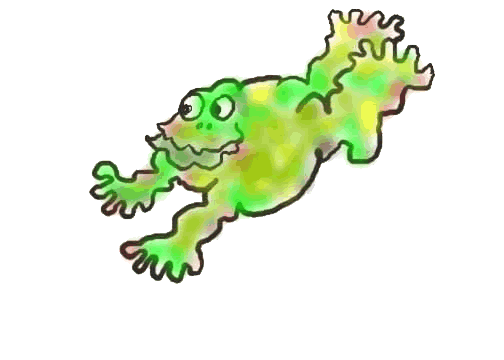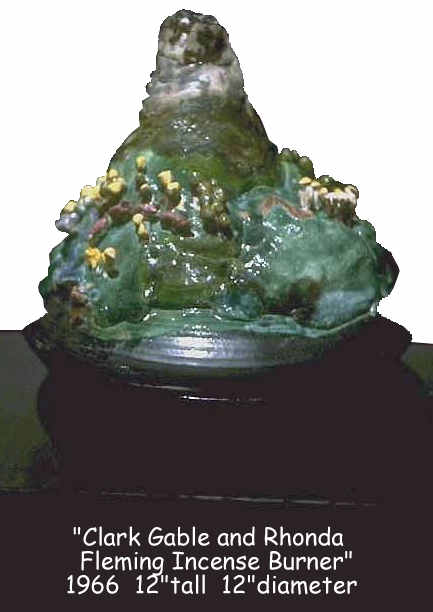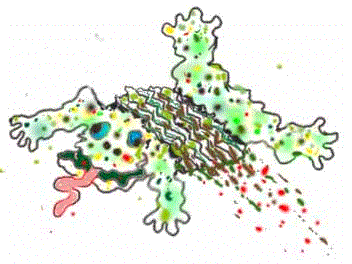Contents
Other Works on Paper
Food & Planets
Plexiglas
Shadow BoxesGallery
Click on any image for a larger view. Then click "back" to return to this page.
Did you come to this site in a frame? Want to get out? Click here!
David Gilhooly

Funk Ceramics
The TB-9 Years
The Gilhooly family was living in Puerto Rico, where Gilhooly's father, a veterinarian for the USDA (United States Dept. of Agriculture) was stationed in 1961. In the Fall, he boarded a plane to Florida, caught a bus to San Bernadino, California, bought a car and drove to Davis, California where he would start his freshman year.
"I first got into ceramics trying to impress a girl. I had majored in biology and later, anthropology and was in danger of failing German, English, chemistry and other requirements. I met an art major in the Spring of 1962 and to impress her, I pre-enrolled in two art classes for the following fall. The first class was beginning drawing with Wayne Thiebaud and the second was to be the first ceramics class taught by Robert Arneson at the University of California at Davis"
At that time UCD was a predominantly agricultural college that
secretly harbored one of the most avant-garde art departments on the West Coast. Thanks to the careful planning and direction of then Chairman, Robert Nelson, a very innovative and unique department was being developed year by year. He already had a faculty that included Wayne Theibaud, William Wiley and Roland Petersen. After Robert Arneson was hired , Manuel Neri, and Roy DeForest were, in the next few years, added to the growing department. UCD's fledgling art department was spread around the campus from TB-9 (temporary building 9, but it's still there) for ceramics and sculpture, to a large section of one of the oldest buildings on campus, East Hall, which housed painting, drawing and the department office, with print making classes held in yet another building.
"On the first day of class, all prospective students gathered at TB-9. It seemed there were about 50 women, with no sign of the object of my affections, and me. She'd left school that summer to get married! To get the class down to a manageable size, Arneson asked the art majors and minors to identify themselves and for some reason I lied and said I was an art minor. He was glad to have me aboard because as the only other male in the class he saw in me a person who could sweep up and make the clay. That summer during the summer session Bob made me his assistant and I remained his assistant until I received my master's degree in 1967."
TB-9, a metal building with insulation sprayed on the inside that only served to make it extra hot in the summer and extra cold in the winter, was to be David Gilhooly's home for the next five years and every summer until 1977.
"We were using heavily reduced stoneware at that time and were given a deadline for the throwing of our first 6" cylinder. Bob also taught us glaze calculation by proportional formulas and told us to keep records and
photograph all our work. But we didn't make nice cups, bottles or pots. Once off the wheel, we beat them up, rolled them on the floor or threw lumps of clay at them. Stoneware was good for that, but otherwise it was very limiting. We couldn't make things thick, colorful or really delicate or complex. Bob tried mixing vermiculite into the clay which made it blow up in the kiln. Eventually, another student, Peter Vandenberge, found that by mixing perlite into the clay we could fire things that were relatively really thick, quickly, without having them blow up in the kiln and it also reduced the weight of the object. The only problem was that low-fire glazes wouldn't absorb into the clay body, they'd run and pool at the bottom of the kiln shelf."
Gilhooly left TB-9 for one semester to become Manuel
Neri's assistant and started making things out of lumber, fur, neon lights and asbestos shingles. He made furniture like the Elephant Foot Ottoman, fur covered candy and ice cream bars. But it didn't last and when he went back to TB-9, Bob had discovered low-fire white earthenware, lowfire glazes and two new students, Chris Unterseher, a surfer from Santa Barbara, California and Margaret Dodd from Australia. It was then, in 1965, that Robert Arneson, Peter Vandenberge, David Gilhooly, Chris Unterseher and Margaret Dodd began making the first ceramic objects which would later be known as Funk Ceramics. Working 16 hours or more a day in TB-9 the group hardly knew that the rest of the art world existed at all. Arneson showed his students slides of abstract expressionist clay and a very few historical objects. They enjoyed pouring over catalogs of Claes Oldenburg's work. But the opening of the Avery Brundage collection of Asian Art at the De Young Museum in Golden Gate Park (San Francisco, California) impressed them most.
"It was there that I first saw Tang Dynasty hilltop Jars, little cylindrical lidded pots with little scenes on the lids."
Gilhooly had been making little scenes depicting the Tarzan and other movies of his youth, but was always unhappy with the consequences. Sculpturally they were too flat and even when lifted on pedestals never seemed to work visually. The hilltop jars solved the problem for him and he began making lidded cookie jars, casseroles, cookie jars and incense burners with movie scenes on the lids. The vessels served to lift the scenes and give them a more visual importance. These were some of Gilhooly's first Funk pieces. The term, Funk, was coined in 1966 by Peter Selz for a show at the University of California Art Museum in Berkeley, California. The implied meaning was something common, dopey, stupid or low. Shows of Funk Art were often met with the question, "What, you call this Art?" Gilhooly and his cohorts, tiring of hearing this, would often answer, "No, we call it George!" (or any other name.)

"The most clever thing I made was Clark Gable and Rhonda Fleming on the Slopes of Kilamenjaro Incense Burner. When you put a cigarette or incense cone in the bottom, the smoke would come out the top of the volcano."
The newly concocted whiteware (1/2 Kaolin, 1/2 talc and perlite "to taste") also made extremely large pieces possible because the piece would dry evenly without cracking, was lighter depending on how much perlite was added to the clay, and fired evenly which reduced cracking and breakage in the kiln.
"I ended up making large, often life-sized, animals by pounding out a slab of clay on a burlap sack to give it texture and draping it over a mound of excelsior which supported the clay while I pushed and pulled it into shape. Then I'd add legs, a tail and other details.
Using excelsior had a lot of advantages. It compressed during the drying process which reduced cracking and breaking and any shreds that stuck to the unfired piece vaporized during the bisque (first firing to harden the clay body) firing. Shredded newspaper was the next best thing although it was not as rigid. The first things I made were a ten foot Nile Crocodile and the Emma Hippo Memorial named after a pharmacist that I had worked for at age, 16. All of the African animals I made were named for friends, relatives, teachers or colleagues which often got me into trouble."
Last revised May 7, 1999
